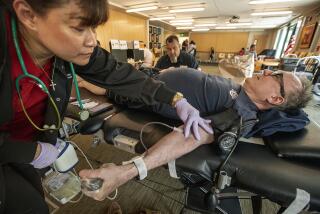Rules Changed to Allow More Blood Donations
- Share via
SACRAMENTO — In an effort to increase the state’s blood supply, donors will be allowed to give blood as many as seven times a year, state Health Services Director Kenneth W. Kizer announced Monday.
Under previous state regulations, donors could give blood every eight weeks but not more than five times in a year. The new regulation that took effect last month still allows donations every eight weeks but eliminates the annual limit, thus increasing the number of possible donations in a year to six or seven.
“If people donated on a regular basis, that might mean as much as 200,000 to 300,000 extra units of blood each year in California,” Kizer said. “We’re always in a precarious balance at different times as to the amount of blood that’s needed, versus what is available. So we think this will be a significant improvement in helping the state’s blood supply.”
To publicize the new rule, Kizer and 10 members of his staff visited a Sacramento blood bank and gave their own blood, as half a dozen television crews filmed the event.
Dangerously Low
Kizer said blood supplies could fall dangerously low during the coming holiday season when donations typically drop off, and he encouraged members of the public to give blood.
The state’s top health official also said many potential donors have been scared away by the “unfounded fear” that they could contract AIDS by giving blood. Kizer stressed that individuals face no increased risk of contracting acquired immune deficiency syndrome by giving blood.
Increasing the number of times a donor can give blood to as many as seven times a year does not pose a health problem, Kizer said, because the eight-week period between donations remains the same.
Most people regenerate their blood sooner than eight weeks after making a donation, he said, but the eight-week limit will remain to ensure that the health of a regular donor is not jeopardized by giving blood too frequently.
All prospective donors will continue to be screened by blood banks to make sure that they are healthy enough to give blood, Kizer noted.
Gerry Sohle, a Los Angeles spokeswoman for the American Red Cross, said blood centers already turn away about 10% of donors because tests show that they have health problems or that their systems are not regenerating blood fast enough.
“They will continue to be tested every time they come in,” Sohle said.
The new regulation, she added, has not generated “any real health concern.”
Consider Tests
In Los Angeles, meanwhile, the Hospital Council of Southern California and the Los Angeles County Medical Assn. issued a statement advising patients who received blood transfusions from 1977 to 1985 to consider being tested for the AIDS virus.
The medical groups issued the advisory after news reports last week revealed that 21 babies who received blood transfusions at Cedars-Sinai Medical Center between 1980 and 1985 were infected with the AIDS virus, according to council spokesman David Langness.
No blood test for exposure to the AIDS virus was available until March, 1985. People who received blood transfusions before that time and after 1977, when the AIDS virus is believed to have entered the blood supply, may be at risk of developing the disease, according to Stephen Gamble of the hospital council.
He cautioned against panic, however, saying that the majority of people who are tested will show negative results.
The federal Centers for Disease Control in Atlanta said that AIDS infections caused by the transfusions of contaminated blood or blood products have dropped sharply since blood banks started testing donors for the presence of AIDS antibodies in March, 1985.
Prior to screening, the chances of contracting the disease through a blood transfusion were about one in 1,500 in Southern California, officials from the agencies said. The chances are about one in 50,000 to 200,000 today.
More to Read
Sign up for Essential California
The most important California stories and recommendations in your inbox every morning.
You may occasionally receive promotional content from the Los Angeles Times.













